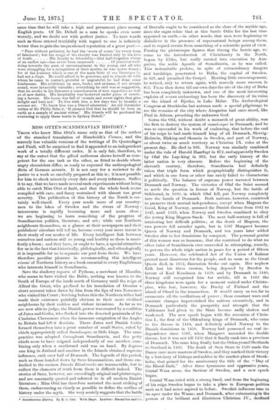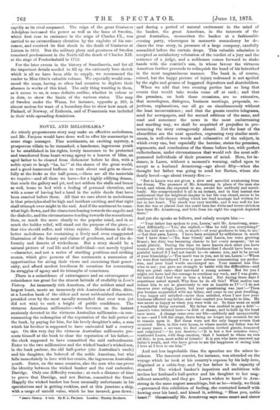MISS OTTE'S SCANDINAVIAN HISTORY.*
THOSE who know Miss ottes name only as that of the author ,of the standard translation of Humboldt's Co.smos, and the scarcely less valuable versions of the writings of De Quatrefages and Pauli, will be surprised to find it appended to an independent -work of a totally different order. It is only fair, therefore, to *Jay at the outset that the gifted authoress shows herself as com- petent for the one task as the other, as fitted to decide where angry chroniclers differ, as ready to expound the anthropological dicta of German savants. It is not easy for a reviewer to do justice to a work so carefully prepared as this is ; it is not possible for him to check minutely every date and every reference. Suffice it to say, that we have made several such experiments without being able to catch Miss Ottd at fault, and that the whole book seems compiled with care, and fancy restrained with almost too great severity. The publication of this history of the North is cer- tainly well-timed. Every year sends more of our country- men to the lakes of Sweden and the rivers of Norway ; intercourse is rapidly becoming more and more close ; we are beginning to learn something of the progress of Scandinavian politics, literature, and art ; while our Northern neighbours themselves, as a glance at their newspapers and their publishers' circulars will tell us, become every year more intent in their study of our modes of life. Every intelligent link between ourselves and nations still so young and healthy as these is mani- festly a boon ; and they have, or ought to have, a special attraction for us in the fact that historically, philologically, and ethnologically it is impossible for us to separate our past from theirs. We have therefore peculiar pleasure in recommending this intelligent resume' of Northern history as a book essential to every Englishman who interests himself in Scandinavia.
Save the shadowy reports of Pytheas, a merchant of Alassilia, who seems to have visited the Baltic, nothing was known to the South of Europe of the lands north of Germany until the reign of Alfred the Great, who prefixed to his translation of Orosius a short account taken down by him from the lips of two Norsemen who visited his Court ; but long before this the Northern tribes had made their existence painfully obvious to their more civilised neighbours by their sudden and violent invasions. As far as we are now able to judge, the Danish power was created by a coalition of Jutes and Goths, who flocked into the deserted peninsula of the Cimbrian Chersonese when the immense emigration of the Angles to Britain had left it desolate. There Jutes and Danish Goths formed themselves into a great number of small States, ruled by chiefs appropriately called Smaakongar, or little kings. The same practice was adopted throughout Scandinavia, and the petty chiefs seem to have reigned independently of one another, com- bining only when a southward raid was on hand. By degrees one king in Jutland and another in the Islands obtained supreme influence, each over half of Denmark. The legends of this period, such as those handed down by Saxo Grammaticus, and those em- bodied in the curious Dauske Riimkronike are innumerable, but to collect the elements of truth from them is difficult indeed. The stories of Saxo, however, are exceedingly original and picturesque, and are constantly quoted and referred to in all modern Danish literature ; Miss Ottd has therefore narrated the most striking of them, endeavouring as clearly as possible to define the outline of history under the myth. She very acutely suggests that the battle • Scandinavian History. By E. C. Otti. With Maps. London: Macmillan sad Co. of Bravalla ought to be considered as the close of the mythic age, since the sagas relate that at this battle Odin for the last time appeared on earth,—iu other words, that men were beginning to disbelieve in the presence of supernatural beings among them, and to regard events from something of a scientific point of view. Passing the picturesque figures that throng the heroic age, we come to the introduction of Christianity in the North, begun by Ebbo, but really carried into execution by Ans- garius, the noble Apostle of Scandinavia, as he was called. This indomitable prelate, in spite of extraordinary dangers and hardships, penetrated to Birks, the capital of Sweden, in 829, and preached the Gospel. Meeting little encouragement, he retired, only to return again, with scarcely more success, in 853. From then down till our own days the site of the city of Birka has been completely unknown, and one of the most interesting exploits of recent archaeology has been the discovery of its ruins on the island of Bjiirkii, in Lake Millar. The Archawlogical Congress at Stockholm last autumn made a special pilgrimage to see the remains of the city where Ansgarius had once stood, like Paul in Athens, preaching the unknown God.
Gorm the Old, without doubt a monarch of great ability, was the first to destroy the system of smaakougar in Denmark, and he was so successful in his work of coalescing, that before the end of his reign he had made himself king of all Denmark, Slesvig- Holstein, Blaking and Skaania in Sweden, and part of Norway, or about twice as much territory as Christian IX. rules at the present day. He died in 936. Norway was similarly combined under the rule of Harold Haarfagr in 872, and apparently Sweden by Olaf the Lap-king in 993, but the early history of the latter nation is very obscure. Before the beginning of the eleventh century, therefore, Scandinavia had definitely taken that triple form which geographically distinguishes it, and which in one form or other has rarely failed to characterise it politically. The balance of supreme power wavered between Denmark and Norway. The victories of Olaf the Saint seemed to settle the question in favour of Norway, but the battle of Stiklestad, in 1030, in which Olaf fell, put Norway completely into the hands of Denmark. Both nations, however, contrived to preserve their mutual independence, except when Magnus the Good, King of Norway, assumed the Danish throne from 1042 to 1047, until 1319, when Norway and Sweden combined to obey the young King Magnus Smek. The next half-century is full of interesting but difficult politics ; at the death of Magnus, the two powers fell asunder again, but in 1387 Margaret became Queen of Norway and Denmark, and ten years later added Sweden also to her dominions by conquest. The personal genius of this woman was so immense, that she contrived to do what no other ruler of Scandinavia ever succeeded in attempting, namely, to govern the whole triple nation in peace for a period of fifteen years. However, the celebrated Act of the Union of Kalmar proved most disastrous for the people, and as soon as the Great Queen died, in 1412, dissension broke out again. Iler nephew Erik lost his three crowns, being deposed by Sweden in favour of Karl Kundsson in 1439, and by Denmark in 1440. Norway still recognised him for awhile, till in 1442 the three kingdoms were again for a moment united under Christo- pher, who lost, however, the Duchy of Finland and the island of Oland in the transaction. It would carry us too far to enumerate all the oscillations of power ; these constant wars and constant changes impoverished the nations excessively, and in Denmark particularly the prosperity and strength that the Valdemars had given to the State became sadly shaken and weakened. The new epoch began with the accession of Chris- tian I., the first of the Oldenburg kings of Denmark, who came to the throne in 1448, and definitely added Norway to the Danish dominions in 1450. Norway had possessed no real in- dependence since 1387, when Margaret ascended the double throne, but it was not till 1450 that it finally sunk into a province of Denmark. The same king finally lost the Orkneys and Shetlands to Scotland in 1469. The death of Sten Sturc in 1520 made the Danes once more masters of Sweden, and they marked their victory by a butchery of bishops and nobles in the market-place of Stock- holm, that gained for the anniversary the title of the "Day of the Blood-Bath." After three tyrannous and oppressive years, Gustaf Wasa arose, the Saviour of Sweden, and a new epoch began.
Gustaf Wass ruled with a strong hand, and from the beginning of his reign Sweden began to take a place in European politics such as it had never aspired to before. Swedish influence rose to its apex under the Wawa; and Denmark, after culminating in the person of the brilliant and illustrious Christian IV., declined rapidly as its rival surpassed. The reign of the great Gustavus Adolphus increased the power as well as the fame of Sweden, which first rose to eminence in the reign of Charles IX., was carried to an extraordinary elevation by the exploits of his suc- cessor, and received its first shock in the death of Gustavus at Liitzen in 1632. But the military glory and greatness of Sweden remained predominant in the North till the death of Charles XII. at the siege of Frederikshald in 1712.
For the later events in the history of Scandinavia, and for all the important details needed to fill up the extremely bare sketch which is all we have been able to supply, we recommend the reader to Miss Otte's valuable volume. We especially would com- mend the maps, having so often had occasion to deplore their absence in works of this kind. The only thing wanting in them, as it seems to us, is some definite outline, whether in colour or in dots, to show the limits of the various states. The map of Sweden under the Wages, for instance, opposite p. 263, is almost useless for want of a boundary-line to show how much of Finland, of Norway, of Esthonia, and of Pomerania was included in their wide-spreading dominions.



































 Previous page
Previous page